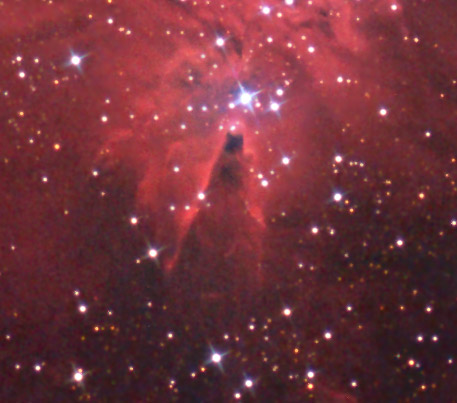| Time Travel Research Center © 2005 Cetin BAL - GSM:+90 05366063183 - Turkey / Denizli | |||||
|

THE CHRISTMAS TREE AND
CONE REGION
NGC
2264 - EMISSION NEBULA PLUS CLUSTER IN MONOCEROS
Just north of Orion in the winter Milky Way constellation of Monoceros, this area of nebulosity makes up one of the most colorful and exciting areas of the night sky. Pictured above is NGC 2264, an open cluster of stars known as the "Christmas Tree" due to its characteristic shape. At the top of the image, and pictured in the inset below, is the Cone Nebula, an areas of stellar growth activity that is one of the more pictured areas of the sky. The rolling nebulosity around the center of the image is known as the "Foxfur." Also pictured here at the lower left corner of the image is NGC 2259, a 10.8 magnitude open star cluster.
|
|
|
Detailed section of the Cone Nebula. |
Date:
December 8, 2004
(Ha info) and December 10, 2004 (color info)
Location: The Ballauer Observatory near Azle, Texas (Ha info)
and Comanche Springs near Crowell, Texas (color info)
Transparency: 4.8 mag zenithal (Ballauer Observatory) and 6.8
mag zenithal (Comanche Springs)
Seeing: 2/10 (Ballauer Observatory) and 3/10 (Comanche Springs)
Temperature: 55 degrees F (Ballauer Observatory) and 38
degrees F (Comanche Springs); camera cooled to -25 degrees C
Scope/Mount: Tak FSQ-106 @ f/5 and Tak NJP mount
Camera: SBIG STL-6303E, self-guided
Exposure Info: Ha(Ha+R)GB, 180:30:30:30 minutes; 15 minute
individual exposures for Ha and 2 minute exposures for RGB; all unbinned.
Processing: Dark frame calibration, deblooming, registration,
artificial flats, gradient removal and Sigma Combine in MaxIm DL 4. Digital
Development and RGB combine in MaxIm DL 4. Ha blending, color balance,
curves, levels, selective sharpening/blurring/despeckle in Photoshop CS.
Extra Notes: Ha info blended into red at 70%. Ha info then used again as luminance at 50%. A string was taped to end of aperture to create the diffraction spikes.
Astronomi Nebula Resimler Astrophotography Galaxy Resimler Yıldız Resimler
Copyright(c) 2003 - 2004 - Cetinbal - All rights reserved.
